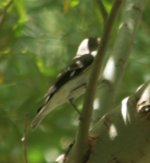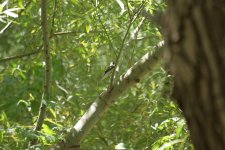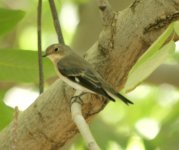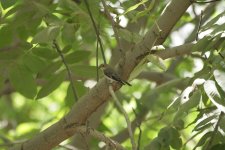Iraq Babbler
Well-known member
Dear birders
Recently, we were able to photograph these two flycatchers ( ad. male and Juvenile) in northern Iraq.
We ID ed the male as a Collared Flycatcher which is vagrant for Iraq, last record was in 1962.
This male was exhibiting broad white collar and white forehead patch (part of it appears behind the twig), large spot on wing base (the bird is flicking its wing in the picture), no white tipped median coverts.
However, I’m not sure about the tail appearance (should it be all dark? is it OK for Collared Flycatchers); however the tail base is not showing cut-edged white, but it appear uniformed dark.
We did not put any name for the juvenile bird (probably a 1st cy female ), but subsequently it should b associated with the adult male ID.
We appreciate experienced views for this bird.
Omar
P.s.
We have the Semi-collared Flycatcher as a regular migrant.
Recently, we were able to photograph these two flycatchers ( ad. male and Juvenile) in northern Iraq.
We ID ed the male as a Collared Flycatcher which is vagrant for Iraq, last record was in 1962.
This male was exhibiting broad white collar and white forehead patch (part of it appears behind the twig), large spot on wing base (the bird is flicking its wing in the picture), no white tipped median coverts.
However, I’m not sure about the tail appearance (should it be all dark? is it OK for Collared Flycatchers); however the tail base is not showing cut-edged white, but it appear uniformed dark.
We did not put any name for the juvenile bird (probably a 1st cy female ), but subsequently it should b associated with the adult male ID.
We appreciate experienced views for this bird.
Omar
P.s.
We have the Semi-collared Flycatcher as a regular migrant.







